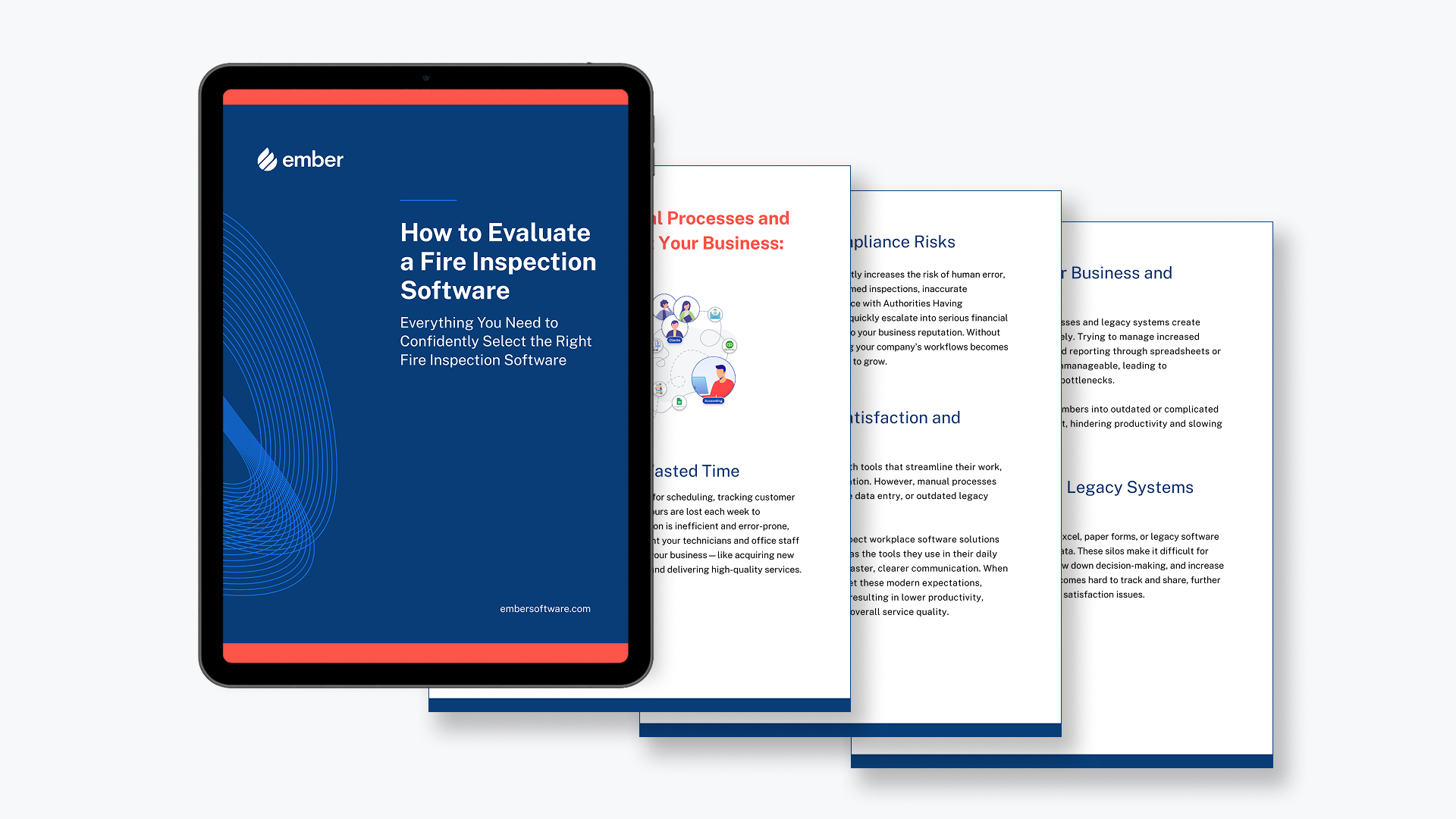5 Ways to Cut Costs and Gain Efficiency in Fire Inspections

Running a fire protection business isn’t just about ensuring buildings are safe—it’s also about staying profitable. Many companies struggle with rising operational costs, inefficient processes, and time-consuming manual tasks that eat into their bottom line. The good news? Small improvements in efficiency can lead to significant cost savings and increased profitability. In this guide, we’ll explore five proven ways to cut costs and make your fire inspection business more efficient.
Each section is packed with actionable insights and real-world statistics to help you implement cost-cutting strategies immediately. Whether you’re looking to eliminate paper-based inefficiencies, optimize scheduling, speed up AHJ submissions, automate proposal workflows, or improve communication, this guide provides everything you need to run a more efficient and profitable operation.
Way #1: Eliminate Paper-Based Processes
The Problem: The Hidden Costs of Paperwork
Traditional paper-based inspection processes are slow, error-prone, and costly. Lost reports, illegible handwriting, and manual data entry create inefficiencies that cost businesses both time and money. A lost report doesn’t just mean redoing potentially hours of work—it’s a situation that can damage a contractor’s reputation and even cost them a customer. Every hour spent searching for misplaced paperwork is an hour that could have been used for revenue-generating activities.
The Solution: Going Digital Saves Time and Money
Switching to digital inspection forms reduces administrative overhead, minimizes errors, and speeds up workflows. With digital tools, technicians can complete inspections on mobile devices using customizable NFPA-compliant forms that auto-populate duplicate data. The office can receive these instantly and quickly turn them around to submit to AHJs or generate proposals—without touching paper or retyping duplicate information.
The Measurable Impact
Businesses that transition to digital processes can experience up to 90% less paperwork, drastically reducing administrative burden and manual errors, according to Ember Software customer insights.
✅ Key Takeaway: Digital tools eliminate paperwork headaches, improve accuracy, and allow teams to focus on more productive tasks.
Way #2: Optimize Technician Scheduling
The Problem: Inefficient Scheduling Wastes Time and Money
Poorly planned team schedules lead to unnecessary travel, missed inspections, and technician downtime—all of which increase costs. Without an optimized scheduling process, businesses struggle with last-minute changes, overbooked technicians, and wasted hours spent coordinating by phone or email.
The Solution: Smarter Scheduling for Higher Efficiency
Using scheduling software allows you to manage the entire team from one dashboard, easily track schedule history, and receive automated appointment reminders to prevent missed inspections. By keeping a centralized view of technician availability and job status, businesses can ensure that every technician’s time is used efficiently.
The Measurable Impact
Companies that implement optimized scheduling see 75% fewer calls and emails, reducing miscommunication and improving operational efficiency.
✅ Key Takeaway: A streamlined scheduling process means fewer headaches, more productive technicians, and fewer costly scheduling mishaps.
Way #3: Reduce AHJ Submission Time & Improve Tracking
The Problem: Slow and Manual AHJ Submissions
Submitting reports to Authorities Having Jurisdiction (AHJs) is often a time-consuming, manual process. Fire protection companies frequently rely on spreadsheets, email chains, or even paper submissions to track reports, making it difficult to ensure everything is submitted on time. Additionally, manual rekeying of data increases the risk of human error, leading to incorrect submissions, missing information, and unnecessary back-and-forth communication. Keeping track of multiple submissions across different jurisdictions becomes tedious and prone to oversight.
The Solution: Digital Submissions for Faster, Error-Free Approvals
Using digital platforms that centralize and automate AHJ submissions allows businesses to streamline the process, eliminating the need for manual tracking. Digital submissions auto-fill required fields, reducing the risk of data entry errors and ensuring reports are submitted accurately the first time. With a digital system, reports can be completed and submitted in just a few clicks, ensuring timely compliance while reducing administrative burden.
The Measurable Impact
Businesses leveraging digital AHJ submissions can experience up to a 10X faster submission process, significantly reducing administrative workload and freeing up time for more revenue-generating activities.
✅ Key Takeaway: Faster, more accurate submissions mean fewer mistakes, less manual work, and improved efficiency across the entire inspection process
Way #4: Automate Deficiency Reports into Proposals & Improve Tracking
The Problem: Missed Revenue & Fragmented Deficiency Tracking
Tracking deficiencies from identification to resolution is often fragmented, requiring inspectors to manually document issues, generate reports, and follow up with corrective actions across different platforms. This disconnected workflow leads to lost information, delays in resolving critical safety issues, and inefficiencies in managing compliance. Additionally, every day that goes by without submitting a proposal decreases the probability that you'll win the job.
The Solution: Automating Deficiency Management & Proposal Generation
Fire protection companies can now streamline deficiency tracking by leveraging fire inspection software that integrates directly with platforms like The Compliance Engine to submit to AHJs and resolve deficiencies efficiently. This eliminates redundant data entry and ensures that deficiencies are documented, tracked, and resolved in one seamless process.
Automating deficiency-to-proposal workflows also allows businesses to generate and send quotes instantly with professional branding, increasing close rates and revenue.
The Measurable Impact
By automating deficiency tracking and proposal generation, fire protection companies can eliminate the need for manual follow-ups, reduce administrative workload by removing duplicate data entry, speed up issue resolution to improve compliance rates, which has been shown to accelerate the sales cycle and improve proposal acceptance rates. A study by Forrester Research found that companies using automated proposal tools experienced a 30% faster sales cycle and an 18% higher close rate.
✅ Key Takeaway: Centralized deficiency tracking and automated proposal generation reduce delays, minimize human error, and improve overall compliance management while increasing revenue opportunities.
Way #5: Improve Communication Between the Office & Field
The Problem: Poor Communication Slows Down Operations
Lack of real-time communication between office staff and field technicians leads to missed appointments, longer inspection times, and inefficient job execution. Without a reliable system for updating schedules, sharing reports, and tracking job progress, businesses suffer from unnecessary rework and lost time.
The Solution: Real-Time Updates for Seamless Coordination
Using a platform that keeps schedules, reports, and job details in sync across teams eliminates confusion and reduces wasted time. When technicians can update job status instantly and office teams can access the latest information in real-time, coordination becomes seamless.
The Measurable Benefit
Businesses that improve communication workflows experience 75% fewer calls and emails, reducing administrative overhead and allowing teams to focus on essential tasks, according to Ember Software customer insights.
✅ Key Takeaway: Keeping your team connected in real time eliminates miscommunication and improves overall efficiency.
Conclusion: Small Changes, Big Savings
Efficiency and cost savings go hand in hand. By eliminating paper-based processes, optimizing scheduling, streamlining AHJ submissions, automating proposals, and improving communication, fire protection contractors can significantly cut costs while increasing productivity.
Take the Next Step
If you're ready to see how digital tools can help you cut costs and improve efficiency, Ember Software streamlines inspections, scheduling, and reporting—all in one platform. Book a free demo today and discover how you can save time and increase profits.
Ready to simplify your fire inspection workflow?
Get Free Demo







